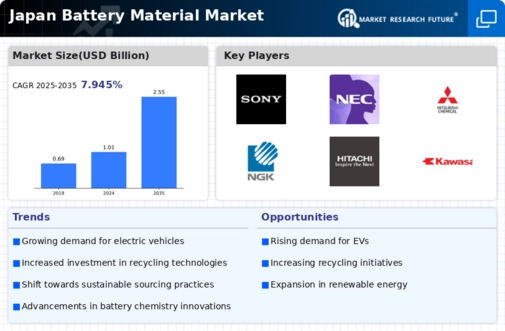The Japan Battery Material Market is characterized by rapid advancements in technology and a growing emphasis on sustainability. As the demand for electric vehicles (EVs) and renewable energy storage solutions escalates, companies within this market are increasingly focusing on providing high-quality materials that can enhance battery efficiency and lifespan. This competitive landscape features a mix of established players and emerging companies, each vying for market share while striving to innovate and respond to changing consumer preferences. Key factors driving competition include the quality of battery materials, pricing strategies, research and development investments, and the ability to form strategic partnerships.
With Japan being a crucial hub for the automotive and electronic sectors, the battery material market is not only significant for domestic consumption but also for global supply chains, influencing trends and standards worldwide. In the context of the Japan Battery Material Market, Sony has carved out a notable presence, leveraging its strong expertise in technology and innovation. Known primarily for its consumer electronics, Sony has diversified its interests to include advanced battery materials.
The company's strengths lie in its extensive research and development capabilities, enabling it to introduce cutting-edge battery solutions that meet the rigorous demands of modern electronics and automotive applications. Sony's commitment to sustainability and environmental stewardship is reflected in its production processes and product offerings, allowing the company to capitalize on the growing consumer preference for eco-friendly materials. Additionally, Sony's established brand reputation and extensive distribution networks strengthen its competitive position within the Japan Battery Material Market. NEC Corporation also plays a significant role in the Japan Battery Material Market, focusing on providing integrated solutions that incorporate advanced battery technologies.
The company is known for its competence in developing energy storage systems that can be utilized across various applications, from renewable energy integration to electric vehicles. NEC Corporation's strengths include a robust portfolio of key products and services designed specifically for enhancing battery performance and reliability. Its commitment to innovation is evident through ongoing investments in research and development, ensuring that it remains at the forefront of emerging technologies. The company has also pursued strategic mergers and acquisitions within Japan, enhancing its technological capabilities and expanding its market reach.
Through these initiatives, NEC Corporation solidifies its standing as a key player in the Japan Battery Material Market, contributing to the evolution of energy solutions in the region.






















Leave a Comment